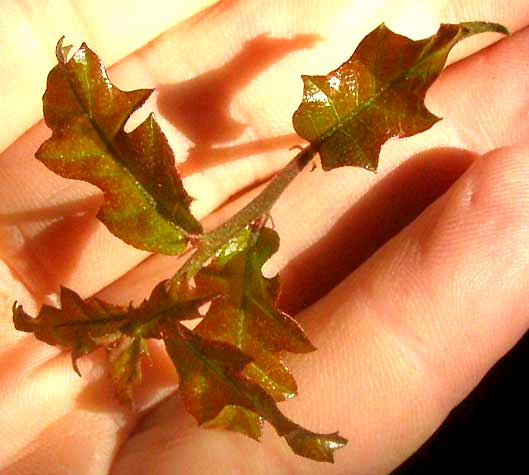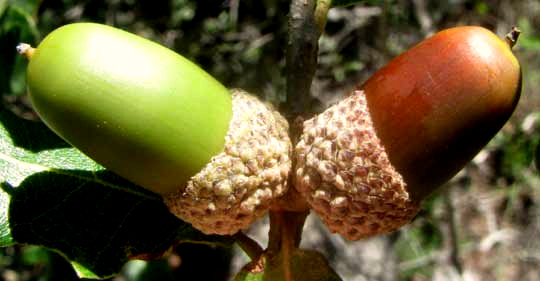Excerpts from Jim Conrad's
Naturalist Newsletter

from the March 31, 2013 Newsletter issued from the Frio Canyon Nature Education Center in northern Uvalde County, southwestern Texas, on the southern border of the Edwards Plateau; elevation ~1750m (~5750 ft); N29.62°, W99.86°; USA
SANDPAPER OAK FLOWERING
On the very thin, dry soil and between cracks in rocks atop the limestone hills lining the Dry Frio River Valley you find plants that don't grow in the valley and on the hills' slopes. Each hilltop constitutes a special ecological island.
One unique tree species growing on these hilltop islands and not elsewhere in the Valley is an oak tree very unlike what most people visualize when they think of oaks. Our hilltop oak hardly grows higher than one's head and it is much branched from the base like a bushy shrub. Its semi-evergreen leaves are tiny compared to most oak leaves, and when the leaves mature they're rough to the touch. Nowadays the little oak is issuing leaves and flowers, as shown above with my finger in the picture for scale. The longish clusters of yellow items are expanding catkins of immature male flowers. A close-up of the tiny leaves is shown below:

Those leaves are nearly as large as they get, the maximum mature length usually being about 1-½ inches (40mm).
Because of the mature leaves' rough upper surfaces this species is often referred to as the Sandpaper Oak, but also it's called Scrub Oak, Scrub Live Oak, Shin Oak, and Pungent Oak. It's QUERCUS PUNGENS, found on dry limestone or igneous slopes, usually in oak, pinyon, and juniper woodlands in the Edwards Plateau region of southwestern Texas, and spottily in chaparral and the Chihuahua Desert in southern Arizona, New Mexico, and all across arid northeastern Mexico.
Sandpaper Oak's leaves are semi-evergreen in the sense that the shrubs on our hilltops have mostly lost their leaves from last year, except along their lower branches. Some branches are sprouting new leaves at their tips even as last year's leaves remain farther back along the stem.
Later in the season it'll be a pleasure seeing the tiny acorns, which reach only about 3/8ths of an inch long (10mm).
from the October 13, 2013 Newsletter issued from the Frio Canyon Nature Education Center in the valley of the Dry Frio River in northern Uvalde County, southwestern Texas, on the southern border of the Edwards Plateau; elevation ~1750m (~5750 ft); N29.62°, W99.86°; USA
SANDPAPER OAK WITH ACORNS
Nowadays the Sandpaper Oaks are bearing handsome acorns and interesting leaves, as seen below:

Below, you can see the acorns closer up:

Because of pictures and drawings I've seen of Sandpaper Oak acorns, I was surprised that our bushes produced acorns with such long nuts. However, the Flora of North America describes the nuts as "broadly ovoid to subcylindric." "Subcylindric" is the same word the expert uses to describe the acorns of the Shin Oaks we looked at last week, and the acorns of that oak were very similar to our Sandpaper Oak's. When identifying oaks in our area, the challenge is to distinguish Sandpaper Oaks from Shin Oaks. And, this is keeping in mind that they hybridize.
In the Flora key, leaf margins of Sandpaper Oaks are described as "strongly undulate," meaning that the margins are wavy, curving up and down relative to the blade's plane. Our first picture portrays leaves with very undulating margins. You can contrast those leaves with the Shin's Oaks, which are described as "planar," or flat, on our Shin Oak page at http://www.backyardnature.net/n/w/shin-oak.htm.